How to Maximize Power Output from Solar Panels
Maximizing the power output from solar panels is essential for getting the best return on your renewable energy investment.
Solar panels are sophisticated devices that convert sunlight into electricity but their performance depends heavily on various factors that can be optimized to extract maximum energy.
Understanding and implementing these optimization strategies can significantly increase your system’s efficiency, reduce payback periods and maximize long-term energy production.
The journey toward optimal solar performance involves both fundamental installation principles and advanced technological solutions.
Each strategy builds upon the others, creating a comprehensive approach that can boost your system’s output by substantial margins.
Whether you’re planning a new installation or looking to improve an existing system, these six key strategies will help you harness the full potential of solar energy.
1. Optimal Panel Placement (Direction & Angle)
The foundation of maximum solar power generation lies in strategic panel placement that captures the most sunlight throughout the day and across seasons.
Proper orientation and tilt angle can make the difference between a mediocre and exceptional solar installation.
Best Ways to Maximize Power Output from Solar Panels
1) Direction Optimization
The directional orientation of your solar panels determines how much direct sunlight they receive during peak solar hours.
In the Northern Hemisphere, panels should face true south to align with the sun’s path across the southern sky.
This positioning ensures maximum exposure during the most productive hours of the day when solar irradiance is strongest.
For Southern Hemisphere installations, true north becomes the optimal direction as the sun travels across the northern portion of the sky.
It’s crucial to distinguish between magnetic south/north and true south/north as magnetic declination can vary significantly by location.
Using a quality compass with declination adjustment or GPS-based solar positioning tools ensures accurate alignment.
The tolerance for directional deviation is relatively forgiving – panels can face up to 30 degrees east or west of true south/north while maintaining 95% of optimal performance.
Each degree of deviation from the ideal direction results in measurable energy losses that compound over the system’s lifetime.
Tilt Angle Calculation
The tilt angle determines how perpendicular your panels are to incoming solar radiation throughout the year.
The general rule of setting tilt angle equal to your latitude provides an excellent starting point for year-round optimization.
This angle balances summer and winter sun positions, maximizing annual energy harvest.
For locations at 30 degrees latitude, a 30-degree tilt captures optimal sunlight across all seasons.
This can be fine-tuned based on energy consumption patterns.
If winter heating represents your primary energy demand, increase the tilt by 10-15 degrees above latitude to capture more low-angle winter sun.
If summer air conditioning dominates your usage, reduce the tilt by 10-15 degrees below latitude for better summer performance.
Ground-mounted systems offer the flexibility for seasonal adjustments where you can manually change the tilt angle twice yearly.
Increasing tilt in winter and decreasing it in summer can boost annual production by 5-10%, though this requires accessible mounting hardware and regular maintenance commitment.
2. Minimize Shading
Minimizing shading is another great way on how to maximize power output from solar panels.
Shading represents one of the most devastating impacts on solar panel performance due to the way photovoltaic cells are electrically connected.
Understanding and eliminating shade sources is crucial for maintaining optimal power output.
Solar panels consist of multiple photovoltaic cells connected in series, creating a chain where electricity flows through each cell sequentially.
When even a small portion of a panel becomes shaded, it acts like a bottleneck that restricts current flow through the entire panel.
A shadow covering just 5-10% of a panel can reduce its output by 50% or more.
The impact extends beyond individual panels because panels in a string are also connected in series.
When one shaded panel in a string produces reduced current, it limits the current flow through all panels in that string.
This cascading effect means a single shaded panel can dramatically reduce the output of an entire array section.
Even partial shading from trees, chimneys, antennas or debris creates significant performance losses.
Moving shadows from tree branches create intermittent shading that causes power fluctuations throughout the day. Bird droppings, leaves or dust accumulation can create localized shading that gradually degrades performance over time.
Shade Elimination Strategies
Effective shade management begins with comprehensive site analysis using tools like solar pathfinders or smartphone apps that map sun paths throughout the year.
This analysis reveals shading patterns during different seasons and times of day, helping identify problematic obstacles.
Tree management represents the most common shading challenge.
Trim branches that cast shadows on panels especially during peak sun hours between 9 AM and 3 PM.
Consider the growth patterns of nearby vegetation as fast-growing trees may require regular maintenance to prevent future shading issues.
Remove or relocate obstacles like antennas, satellite dishes or roof equipment that create shadows on panel arrays.
Sometimes relocating these items by just a few feet can eliminate shading without compromising their functionality.
Technological Solutions
Micro-inverters offer the most effective solution for unavoidable shading conditions.
These devices attach to individual panels, allowing each panel to operate independently.
When one panel experiences shading, it only affects that specific panel’s output while others continue operating at full capacity.
Power optimizers provide a cost-effective alternative that minimizes shading impacts without the full expense of micro-inverters.
These devices condition the DC power from each panel, allowing them to operate at their individual optimal power points despite string-level variations.
Both technologies provide panel-level monitoring that helps identify shading patterns and track individual panel performance over time, enabling proactive maintenance and system optimization.
3. Use High-Efficiency Solar Panels
Panel efficiency directly determines how much power you can generate from available installation space, making efficiency selection crucial for maximizing output per square foot of array area.
Monocrystalline panels achieve the highest efficiency ratings, typically ranging from 20-23% in residential applications.
These panels use silicon crystals grown as single, continuous structures that provide excellent electron mobility and minimal energy losses.
Their uniform crystal structure creates superior performance in both bright sunlight and low-light conditions, making them ideal for maximizing power output in space-constrained installations.
Polycrystalline panels offer efficiency ratings between 15-18% at lower cost than monocrystalline alternatives.
These panels use silicon crystals formed from multiple fragments, creating visible grain boundaries that slightly reduce electron mobility.
While less efficient per square foot, polycrystalline panels can be cost-effective for installations where space isn’t the primary constraint.
Thin-film panels provide the lowest efficiency ratings at 10-13% but offer unique advantages in specific applications.
These panels perform better in high-temperature conditions and partial shading situations, though their low efficiency requires significantly more installation area to achieve equivalent power output.
Advanced Panel Technologies
PERC (Passivated Emitter Rear Cell) technology enhances traditional monocrystalline panels by adding a reflective layer on the rear surface that captures light that would otherwise be lost.
This technology can boost panel efficiency by 1-2 percentage points while maintaining cost-effectiveness for residential applications.
Bifacial panels generate electricity from both front and rear surfaces, capturing reflected light from surrounding surfaces like white roofs, concrete or snow.
These panels can increase energy output by 10-20% compared to traditional single-sided panels, especially in installations with highly reflective surroundings.
Half-cell panels split traditional solar cells in half, reducing internal resistance and improving performance under partial shading conditions.
This technology also reduces hot-spot formation, improving long-term reliability and maintaining higher performance over the panel’s lifetime.
4. Keep Solar Panels Clean
Maintaining clean panel surfaces is essential for optimal light transmission and maximum power generation.
This is a simple and great way on how to maximize power output from solar panels.
Dirt, debris and biological contamination can significantly reduce panel efficiency over time.
Dust accumulation creates a film that reduces light transmission through the panel’s protective glass surface.
Even a thin layer of dust can reduce panel output by 5-10% while heavy contamination can cause losses exceeding 25%.
The impact is more severe in arid climates where dust storms are common and rainfall is insufficient for natural cleaning.
Bird droppings create localized but severe shading that can trigger hot-spot formation and dramatic power losses.
Unlike uniform dust coverage, concentrated droppings can completely block light to specific cells, creating the same cascading effects as physical shading objects.
Pollen, leaves and organic debris combine with moisture to create sticky films that are more difficult to remove than simple dust.
These organic contaminants can promote bacterial or algae growth that further reduces light transmission and can potentially damage panel surfaces over time.
To avoid this, the solar panels should be inspected and cleaned regularly to ensure continuous flawless power output from the solar panels.
5. Install a Solar Tracking System
Solar tracking systems mechanically orient panels to follow the sun’s movement across the sky, significantly increasing energy capture compared to fixed installations.
Single-Axis Tracking Systems
Single-axis trackers rotate panels from east to west throughout the day, following the sun’s daily path across the sky.
These systems typically increase energy output by 25-35% compared to fixed installations by maintaining more perpendicular angles to incoming solar radiation during peak production hours.
The tracking mechanism uses motors and controllers that calculate sun position based on date, time and geographic location.
Advanced systems incorporate light sensors that can adjust for local weather conditions and optimize positioning for actual solar conditions rather than theoretical sun positions.
Single-axis systems work particularly well in locations with high solar irradiance and minimal weather variations.
They’re most cost-effective for larger installations where the increased complexity and maintenance requirements are offset by substantial energy gains.
Dual-Axis Tracking Systems
Dual-axis trackers adjust for both the daily east-west sun movement and seasonal elevation changes, maintaining optimal angles throughout the year.
These sophisticated systems can boost energy output by up to 40% compared to fixed installations by continuously optimizing panel orientation.
The additional complexity of dual-axis systems includes more mechanical components, increased maintenance requirements and higher initial costs.
The superior energy gains can justify these expenses in high-value installations or locations with excellent solar resources.
Dual-axis tracking is most beneficial in locations with high direct normal irradiance where the precision of tracking delivers maximum value.
Areas with frequent cloud cover may not realize the full benefits of dual-axis tracking since diffuse light doesn’t require precise orientation for optimal capture.
6. Use an MPPT Charge Controller
Maximum Power Point Tracking charge controllers optimize power extraction from solar panels, particularly in battery-based systems where voltage matching between panels and batteries affects overall efficiency.
MPPT controllers continuously monitor panel voltage and current to identify the combination that produces maximum power output.
Solar panels have a characteristic curve where power output peaks at a specific voltage point that varies with sunlight intensity and temperature conditions.
Traditional PWM (Pulse Width Modulation) controllers simply switch panel output on and off to regulate battery charging essentially pulling panel voltage down to battery voltage levels.
This approach wastes potential power when panel voltage significantly exceeds battery voltage, particularly during cold weather when panel voltage increases.
MPPT controllers use DC-to-DC conversion to extract maximum power from panels while providing appropriate charging voltage to batteries. This technology can extract 20-30% more power than PWM controllers, especially when panel voltage substantially exceeds battery bank voltage.
MPPT controllers excel in off-grid and battery-based systems where maximizing energy harvest is crucial for system reliability.
The efficiency gains are most pronounced when using higher voltage panels (24V or 48V) to charge lower voltage battery banks (12V or 24V).
Conclusion
Maximizing solar panel power output requires a comprehensive approach that addresses installation fundamentals, ongoing maintenance and advanced technological solutions.
Each strategy contributes to overall system performance with combined benefits often exceeding the sum of individual improvements.
Start with proper panel placement and shading elimination as these fundamental factors provide the foundation for all other optimizations.
Invest in high-efficiency panels and MPPT controllers for systems where space constraints or energy maximization justify the additional costs.
Implement regular cleaning and maintenance schedules to preserve optimal performance over your system’s lifetime.
how to power appliances directly from solar panels without battery
Why Some Hybrid Inverters Cannot Power Load Directly From Solar Panels






